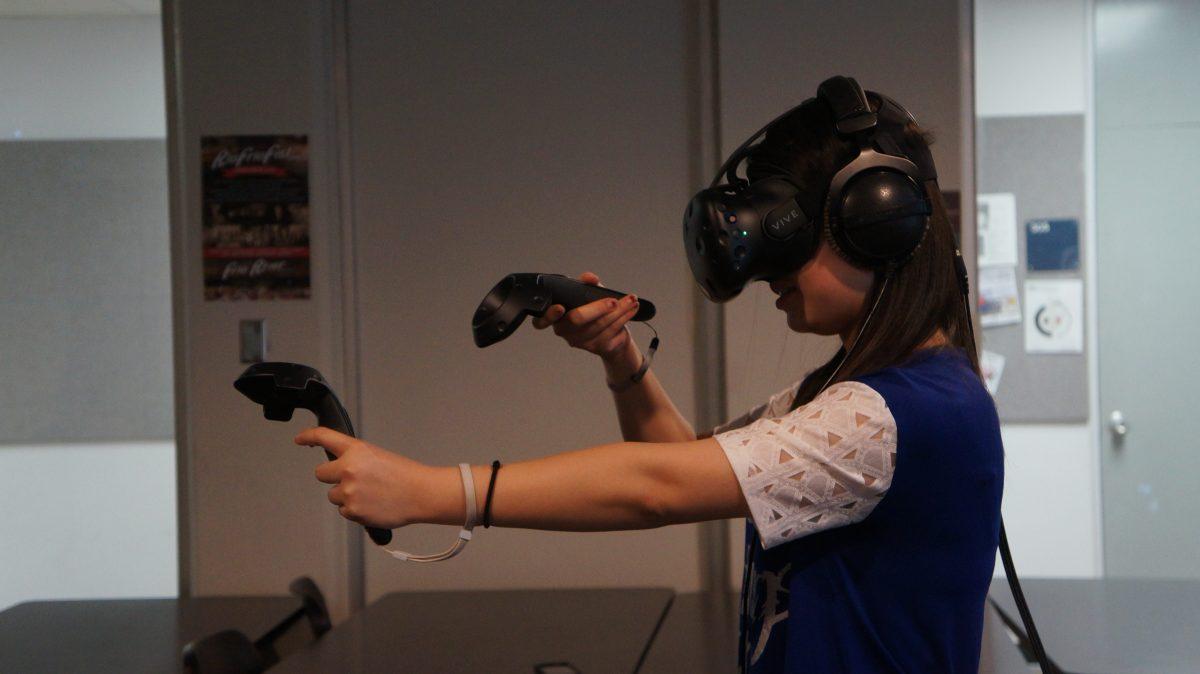Imagine ending a long stressful day when nothing seemed to go right and all you want to do is escape to the blissful, soothing Hawaii beaches — with advancements in virtual reality, this is possible for anyone even from their own bedroom.
Texas A&M student developers are researching how to improve and apply virtual reality beyond the first generation of headsets and motion controllers. Virtual reality (VR) is a computer-generated 3D simulation of a world in which viewers experience a different environment, creating a life-like feeling. VR is currently being used in gaming, architecture and aviation among other fields of study and has the ability to revolutionize the way people communicate, educate and train in multiple professions.
Armani Cassel, a meteorology senior and president of the Texas A&M University Virtual and Augmented Reality (TAMUVR) student organization, began his endeavor into VR after introducing himself to Google Cardboard in 2014 and has been working to visualize datasets using VR since then. Cassel said VR can have a practical use in education, enhancing students’ ability to learn by allowing them to watch events unfold around them.
“One of the most revolutionary things about VR in the future, in my opinion, will be related to education and how classrooms as we know them can take different forms with VR,” Cassel said. “Not only can traditional classes be enhanced, but their online components and online classes can also explore topics with a higher level of interactivity. For example, in reviewing for a biology exam coming up, think of yourself taking a virtual field trip into the central nervous system to touch neurons with your own tracked hands on eCampus.”
Shyam Prathish Sargunam, a graduate student in visualization, was introduced into VR by Google Cardboard and has pursued a way to improve VR into a mainstream form of visual consumption. Sargunam said he applies his degree into researching and developing software to improve VR.
“Where virtual reality can benefit us is by using it to train soldiers, doctors, teachers, and any profession you can think of,” Sargunam said. “Not only will they bring experience to professional careers, virtual reality can allow for an immersion into video games unprecedented in depicting realism.”
Cassel said that augmented reality (AR) allows for simulated interactive experiences that blend computer-generated overlays with the outside world unlike encased head-mounted displays (HMDs) such as the Oculus Rift or HTC Vive.
“Transparent HMDs like the Microsoft Hololens are able to spatially scan a room’s real shape into memory to place virtual objects and keep them there if you look away,” Cassel said. “I agree with Apple CEO Tim Cook that AR will be more important in the future for shared social interaction with virtual objects, but there will still be lessons to learn from Google Glass on how to combat certain social stigmas associated with wearing smart glasses as they get smaller.”
Klin Rothenberger, a electrical engineering junior and active TAMUVR member, said he hopes to work for Oculus upon graduation and VR has many advantages over traveling and experiencing places in person.
“When [virtual reality] becomes good enough to be indistinguishable from real life and easy to use, it becomes this ultimate medium,” Rothenberger said. “No longer do you have to pay for airline tickets and take vacation days when you can just see the same tourist attractions from the convenience and comfort of your home.”
Cassel said VR works in different forms of hardware — not just HMDs — and that advancements in VR and AR hardware will be revolutionary, especially in regards to the past 20 or more years.
“VR does not solely exist in the form of a head-mounted display like an Oculus Rift,” Cassel said. “A ‘cave automatic virtual environment’ can use a system of wall projectors around a room surrounding the user to create a similar if not better simulation than HMDs.”
Rothenberger suggested that virtual reality has a stronger application as a means of communication than just a fancy way to consume entertainment such as video games and movies.
“You could face time [your parents] but why is that a problem?” Rothenberger asked. “It is still a screen, a window you are looking through. VR allows the person you are talking to a real form, a real body, in 3D you can see.”
Cassel said he invites students to join TAMUVR.
“[It] exists to give students the opportunity to use and learn how to code on VR and AR hardware that would fiscally challenging to obtain,” Cassel said. “Students can stay updated on TAMUVR meetings [and] speakers by emailing tamuvr@gmail.com to join the listserv, joining our TAMUVR Facebook group and [or] following TAMUVR on Twitter.”
Escape one world, enter another
October 6, 2016
0
Donate to The Battalion
$2065
$5000
Contributed
Our Goal
Your donation will support the student journalists of Texas A&M University - College Station. Your contribution will allow us to purchase equipment and cover our annual website hosting costs, in addition to paying freelance staffers for their work, travel costs for coverage and more!
More to Discover










